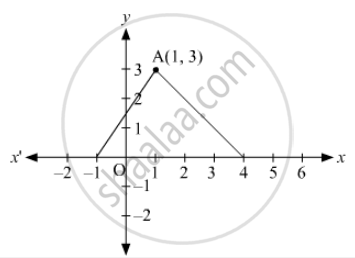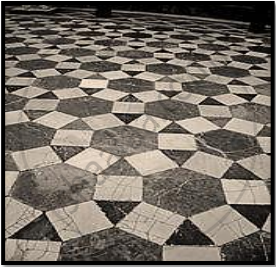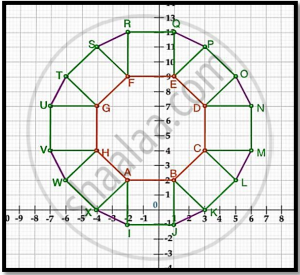Advertisements
Advertisements
प्रश्न
If (−2, 3), (4, −3) and (4, 5) are the mid-points of the sides of a triangle, find the coordinates of its centroid.
उत्तर
Let ΔABC be ant triangle such that P (−2, 3); Q (4,−3) and R (4, 5) are the mid-points of the sides AB, BC, CA respectively.
We have to find the co-ordinates of the centroid of the triangle.
Let the vertices of the triangle be`A(x_1,y_1);B(x_2,y_2);C(x_3,y_3)`
In general to find the mid-point p(x,y) of two points`A(x_1,y_1)`and`B(x_2,y_2)` we use section formula as,
`p(x,y)=((x_1+x_2)/2,(y_1+y_2)/2)`
So, co-ordinates of P,
`(-2,3)=((x_1+x_2)/2,(y_1+y_2)/2)`
Equate the x component on both the sides to get,
`x_1+x_2=-4` .........(1)
Similarly,
`y_1+y_2=6` ..........(2)
Similary, co-ordinates of Q
`(4,-3)=((x_3+x_2)/2,(y_3+y_2)/2)`
Equate the x component on both the sides to get,
`x_3+x_2=8`.........(3)
Similarly,
`y_3+y_2=-6 `..........(4)
Equate the x componet on both the sides to get,
`x_3+x_1=8`..........(5)
Similarly,
`y_3+y_1=10`..........(6)
Add equation (1) (3) and (5) to get,
`2(x_1+x_2+x_3)=12 `
`x_1+x_2+x_3 =6`
Similarly, add equation (2) (4) and (6) to get,
`2(y_1+y_2+y_3)=10`
`y_1+y_2+y_3=5`
We know that the co-ordinates of the centroid G of a triangle whose vertices are
`(x_1,y_1), (x_2,y_2),(x_3,y_3) is `
`G((x_1+x_2+x_3)/3,( y_1+y_2+y_3)/3)`
So, centroid Gof a triangle `triangle ABC `is ,
`G(2,5/3)`
APPEARS IN
संबंधित प्रश्न
Which point on the y-axis is equidistant from (2, 3) and (−4, 1)?
The line segment joining the points A(3,−4) and B(1,2) is trisected at the points P(p,−2) and Q `(5/3,q)`. Find the values of p and q.
In what ratio is the line segment joining the points A(-2, -3) and B(3,7) divided by the yaxis? Also, find the coordinates of the point of division.
If the point `P (1/2,y)` lies on the line segment joining the points A(3, -5) and B(-7, 9) then find the ratio in which P divides AB. Also, find the value of y.
Find the area of the triangle formed by joining the midpoints of the sides of the triangle whose vertices are A(2,1) B(4,3) and C(2,5)
ABCD is a rectangle whose three vertices are A(4,0), C(4,3) and D(0,3). Find the length of one its diagonal.
Find the ratio in which the line segment joining the points A(3, 8) and B(–9, 3) is divided by the Y– axis.
If P ( 9a -2 , - b) divides the line segment joining A (3a + 1 , - 3 ) and B (8a, 5) in the ratio 3 : 1 , find the values of a and b .
In \[∆\] ABC , the coordinates of vertex A are (0, - 1) and D (1,0) and E(0,10) respectively the mid-points of the sides AB and AC . If F is the mid-points of the side BC , find the area of \[∆\] DEF.
If the points A(−1, −4), B(b, c) and C(5, −1) are collinear and 2b + c = 4, find the values of b and c.
Write the ratio in which the line segment joining points (2, 3) and (3, −2) is divided by X axis.
If the distance between points (x, 0) and (0, 3) is 5, what are the values of x?
If the distance between the points (3, 0) and (0, y) is 5 units and y is positive. then what is the value of y?
If x is a positive integer such that the distance between points P (x, 2) and Q (3, −6) is 10 units, then x =
If three points (0, 0), \[\left( 3, \sqrt{3} \right)\] and (3, λ) form an equilateral triangle, then λ =
In Fig. 14.46, the area of ΔABC (in square units) is

In which quadrant does the point (-4, -3) lie?
The point R divides the line segment AB, where A(−4, 0) and B(0, 6) such that AR=34AB.">AR = `3/4`AB. Find the coordinates of R.
A tiling or tessellation of a flat surface is the covering of a plane using one or more geometric shapes, called tiles, with no overlaps and no gaps. Historically, tessellations were used in ancient Rome and in Islamic art. You may find tessellation patterns on floors, walls, paintings etc. Shown below is a tiled floor in the archaeological Museum of Seville, made using squares, triangles and hexagons.

A craftsman thought of making a floor pattern after being inspired by the above design. To ensure accuracy in his work, he made the pattern on the Cartesian plane. He used regular octagons, squares and triangles for his floor tessellation pattern

Use the above figure to answer the questions that follow:
- What is the length of the line segment joining points B and F?
- The centre ‘Z’ of the figure will be the point of intersection of the diagonals of quadrilateral WXOP. Then what are the coordinates of Z?
- What are the coordinates of the point on y-axis equidistant from A and G?
OR
What is the area of Trapezium AFGH?
